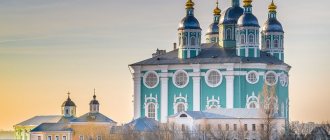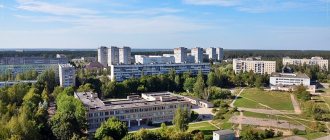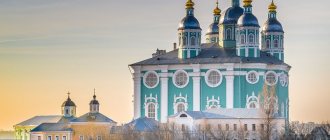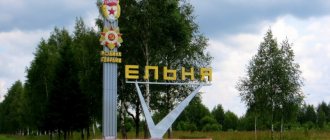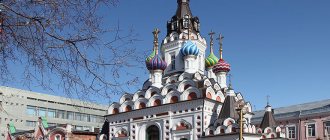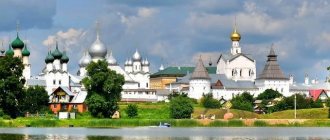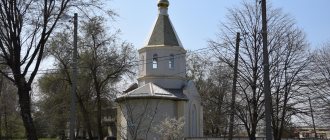The history of Smolensk begins along with the history of the Old Russian land. According to one version, the name of the city on the Dnieper comes from the Slavic designation for the black, swampy land on which the city was built - smol. Others claim that the city's inhabitants produced resin to strengthen boats. They were called Smolensk.
In 882, Prince Oleg annexed Smolensk to his lands, uniting two centers under his rule - Kyiv and Novgorod.
All events that took place in Russian and Russian history were one way or another reflected in the history of this city.
The formation of statehood, the great “zamyatnya” (civil strife), the Time of Troubles, the Napoleonic invasion and the Great Patriotic War. It is enough to walk around the city and get acquainted with its sights - history comes to life.
- Guide to the Smolensk region: what else you must visit besides Smolensk itself.
- If you are traveling to Smolensk by car from Moscow, you can stop at two interesting cities along the way - Mozhaisk and Vyazma.
Interesting cities
The main city of the Smolensk region is one of the oldest Russian cities, which has been mentioned in chronicles since 863. In the Middle Ages it was the center of the Krivichi tribal union. Modern Smolensk
- a hero city with more than 320 thousand inhabitants. Most tourists come to the historical center of the Smolensk region in the summer and on New Year's holidays.
View of the Smolensk fortress wall
Beautiful and provincially cozy, Vyazma was founded in 1239 and received city status in 1723. Ancient Vyazma pleases with a well-preserved merchant center, an abundance of churches and mansions. It is interesting to look at the monuments and the Spasskaya Tower - the only building that has survived from the Vyazemsk fortress of the 17th century.
The city of Gagarin, which until 1968 was called Gzhatsk, is the birthplace of the first cosmonaut Yuri Gagarin. Now it is a modern center with a population of more than 28 thousand people, where various industrial enterprises operate.
View of the Spasskaya Tower in Vyazma
One of the oldest cities in the Smolensk region, Yelnya, appeared in 1150. Today, less than 8,600 people live in the small town, and there is a local history museum. In the village of Novospasskoye, near Yelnya, tourists are greeted by the memorial museum-estate of the composer M. I. Glinka.
People come to ancient Roslavl, a city on the picturesque bank of the Oster River, to look at ancient churches and monasteries. Here there is a monument to the founder of the city - Prince Rostislav Mstislavich and monuments of the new period - the T-34 tank, the L-2012 steam locomotive and an unusual tank locomotive.
Museum-estate of composer M. I. Glinka in the village of Novospasskoye
Vyazma
If Gagarin could still be called a certain periphery of the Moscow region, then Vyazma is the very center of the Smolensk region and the second largest city after Smolensk itself. There are two centers in Vyazma: one is a large alley-park along which the Trinity Cathedral, as well as shopping centers and shops are located; the second is a city park with a memorial, which overlooks the large automobile ring and Sovetskaya Square, where the church is located on the other side of the road.
Soviet square
I left the car and went to explore the surroundings of Vyazma on foot. The structure of the city is confusing. If Gagarin is all flat and clearly divided into squares of blocks and straight streets, then in Vyazma there are many alleys and dead ends. It will be difficult for a beginner to figure it out even from a map.
Sidewalks in Vyazma
The first thing I noticed were the sidewalks. There were practically none of them, that is, it was difficult to find asphalt, mostly there were paths sprinkled with sand.
Streets in Vyazma
There were a lot of grocery stores around, and almost none where you could buy clothes or shoes, if you exclude the market.
Supermarkets and shops on the streets of Vyazma
After walking about three blocks, I finally reached the “first” center and the Trinity Cathedral. Car traffic here is extremely busy. It is noteworthy that in this city, even on wide streets, there is often one-way traffic, which can confuse a non-local driver.
Streets and roads in Vyazma
I also regretfully noticed the poor quality of the roads and the very narrow, obviously budget speed bumps, which can be driven over at a speed of 2-5 km/h without damaging the car. In general, the quality of roads in Vyazma leaves much to be desired, both pedestrian and automobile.
A few new buildings in Vyazma
Having crossed the road, I found myself on the main alley of the city. There were flower beds, trees, benches and even a fountain, but it was clear that this square had not been looked after for a long time: benches were broken in some places, tiles underfoot were still from Soviet times, the fountains were not even plastered. After walking some distance, I turned towards the city park and Efremov Square, where the eternal flame memorial was located.
Efremov Square
Church
This park was in much better condition: the bushes were trimmed, lanterns, new benches, beautiful paving slabs. But as I delved deeper, I began to notice the former devastation. The amusement park doesn't even have night lighting, and there are no visitors or workers. The carousels are old and rusty in some places, it even became creepy. But the beautiful autumn landscapes, trees with yellow leaves and a slightly cloudy sky distracted me.
"New" park
Exit from the park to Sovetskaya Square. And a cat.
While I was walking, I felt that I was hungry. There is a pizzeria not far from the park. Having studied the reviews about it on my smartphone, I decided to have lunch there and ordered pizza to take away. Frankly, the quality left much to be desired, since the dough was thick and was not prepared in front of me, but the price was also reasonable - only 350 rubles per 800 grams.
Stella
Church
After lunch, I decided to take a random walk deep into the city, crossed the bridge over the small Vyazma River, and unexpectedly found myself in some remote area.
Vyazma River
Road from the center of Vyazma
After walking about 300 meters, I just ran into a field. Surprisingly, 15 minutes walk from the center, and now you are standing in a field among dilapidated huts. It felt like an abandoned amusement park, so I hurried to turn back.
Houses near the center
Field 15 minutes walk from the center
View from the bridge to the Vyazma River
There was still time left, so I decided to stop by the village of Khmelita, to the Griboyedov estate. The estate itself is home to the house itself - a real palace, restored and stylized in accordance with the spirit of the 19th century. This was the Griboyedov Museum, and there was also the Nakhimov Museum. However, I was already too tired to visit the museum attractions, so I simply looked around the estate from the outside, walked along the shady autumn alleys and set off on the way back.
Souvenirs
View of the manor house in the Khmelita estate
What can you bring back from your trip? The Smolensk region is famous for its high-quality linen products, beautiful embroidery, excellent ceramics, and skillful crafts made of wood and birch bark. Since 1953, durable Smolensk socks have been produced here. Even astronauts wear products from the Nashe hosiery factory. Bamboo socks are inexpensive and last a very long time.
Many travelers like stained glass enamel, which is called Vyazemskaya stack. Stacks are widely sold in the form of refrigerator magnets.
Trinity Boldin Monastery
Souvenir shops and fairs sell herbal infusions from the Smolensk Poozerie National Park. They are made from dried fireweed and are excellent for home tea drinking.
Tourists willingly buy fragrant Vyazma gingerbreads, which differ from the well-known gingerbreads from Tula and Novgorod. Candied fruits, almonds and peanuts are added to custard Vyazma gingerbreads. They are stored for a very long time - more than six months.
Historical and architectural complex "Teremok"
One of the most popular tasty gifts is Gnezdovo honey bread - an original printed gingerbread, which is prepared according to ancient recipes in the Gnezdovo Museum-Reserve, on the banks of the Dnieper. A modern gastronomic souvenir practically replicates gingerbread cookies from the 11th century.
Legendary Katyn
You should start your journey around the outskirts of Smolensk with a visit to the memorial complex. In 1940, in these places, NKVD officers shot several thousand captured officers from Poland, arrested during the occupation of Polish lands by Soviet troops. This is a scandalous crime, since the secret burial was discovered by German soldiers back in 1943. At the same time, the international commission recognized the guilt of the USSR in committing this massacre. However, after the end of the Second World War, an investigation was carried out by order of the Soviet government, during which it was possible to “find out” that the executions were allegedly carried out by the Germans in 1941. Only in 1990 was justice restored and documents related to massacres in this region were declassified. Very soon the Katyn memorial complex appeared, dedicated to the memory of the victims of the NKVD. According to some reports, victims of repressions were shot here until the 40s of the last century. Today the memorial consists of Russian and Polish parts; there is a long wall with memorial plaques on which the names of fallen officers are engraved and mass graves are decorated. Also included in the memorial complex is a pavilion at the main entrance, where you can see the memorial exhibition “The Totalitarian Past of the Smolensk Region”.
Railway station
Smolensk is not only one of the main tourist centers of the European part of Russia, but also a direct “conductor” abroad (the border with Belarus) and the “face” of Russia for incoming foreigners.
Perhaps that is why the station of the border regional center welcomes guests with a majestic lobby building, made in the neoclassical style in the mid-20th century. The interior decoration also amazes visitors: the lobby is decorated with high arches, columns and even reproductions of famous paintings dedicated to the Smolensk land.
Location: station square - 1.
Assumption Cathedral in Smolensk
One of the most recognizable churches by Russians - the Assumption Cathedral of Smolensk - majestically rises on Cathedral Hill above Smolensk. Even from afar, this cultural monument takes your breath away and makes you feel the most important moments of the ancient history that the city experienced during the Polish Intervention.
The ensemble adorns the temple with five golden domes in the luxurious “Catherine” Baroque style. Despite the devastation of the Great Patriotic War, the Cathedral is also rich in shrines, which visitors can see every day.
Location: Sobornaya Gora street - 5.
Natural attractions
It is often said that the Smolensk region is a forest region. Indeed, approximately 40% of the region is mixed forests, characterized by the richness and diversity of flora and fauna. Famous natural attractions of the Smolensk region: Smolensk Poozerie and Gagarinsky Natural Park. Today these are protected areas of federal significance, in which serious work is being done to protect, study and maintain natural ecosystems. Here you can see rare plants and amazing animals, as well as admire picturesque natural views.
Church of the New Martyrs and Confessors of Russia
This Church can hardly be called an architectural monument, since the building was erected in 2001 - for the first time in more than a century and a half, a new Orthodox church appeared in Smolensk. However, this fact does not detract from the beauty and majesty of the new object of Christian worship. The view of it is open from almost all the streets of the city, especially on sunny days, when the golden domes shimmer from the bright light.
The rich decoration and varied iconostasis attract guests of Smolensk. In addition, a petting zoo is located a hundred meters from the building, which is very convenient for a tourist trip with children.
Location: 25 September street - 37.
